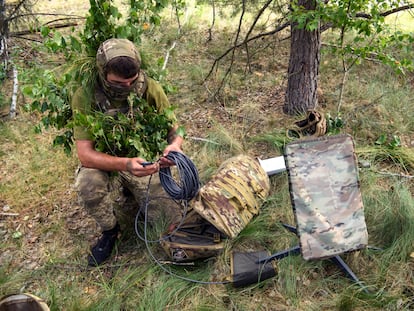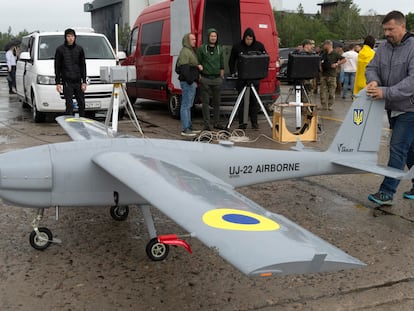Ukraine grinds out 300 feet a day in longest stretch of the war
The Ukrainian military has confirmed a change in tactics in their advance to reduce the number of casualties. Officers are asking for more time to obtain results in the counteroffensive
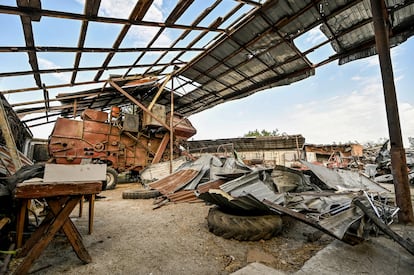

On average, Ukrainian troops are advancing about 300 feet a day in the offensive on the Zaporizhzhia front. This was stated on September 7 by NATO Secretary General Jens Stoltenberg and confirmed by Ukrainian military sources after they were consulted by EL PAÍS. This newspaper has conducted three days of interviews in this region of the front, in the southeast of Ukraine.
Every 300 feet that Ukrainian soldiers progress is at the cost of a high number of casualties. In mid-August, for instance, Alexander’s tank company lost four of its eight tanks while taking a Russian position in the village of Robotyne. The crew members of two of these tanks were burned to death, while the soldiers inside the other two were able to flee in time. Several infantrymen also died as they assaulted the enemy’s trenches.
Alexander’s tank company is now recovering and awaiting reinforcements. The members live camped in forests, next to their vehicles, dispersed in small groups to avoid losing too many units in case of an enemy bombardment. Alexander and the majority of the soldiers interviewed for this report don’t want to provide their full names, because the high command of the Ukrainian Armed Forces has imposed a law of silence in this region. Unless exceptional authorization is granted, the media must stay at least 25 miles away from the frontlines.
The official reason is to protect journalists, while also ensuring that information about the counteroffensive is kept secret. At a military checkpoint in Novomykolaivka, a small town that serves as a logistics base for the Ukrainian Army, an officer gives an example of what they want to avoid: a month and a half ago, a team of French journalists published information about units on the front. Two hours after the publication, according to this officer’s version of events, the Russians bombed the area.
But many soldiers do want to talk. Not to reveal state secrets: they treat conversation as a form of therapy. Alexander was admitted to the hospital for two weeks for post-traumatic stress disorder and heart problems; others were given a few days off after they were attacked in August. He and his fellow soldiers have lived through some of the most difficult experiences in the nearly 19 months of the war: they fought in Kharkiv and, for months, in Bakhmut, in the bloodiest battle of the conflict. But spirits today are more shaken, because advancing 300 feet a day between the lines of Russian defenses is a superhuman feat. The company lives in the forest and they suspect that they will continue living there throughout the winter, because they don’t foresee major advances until December. Also because the houses near the fighting are occupied by medical teams.
EL PAÍS has been able to verify that, compared to other fronts, there are more doctors, field hospitals and pieces of military equipment in this region of Ukraine.
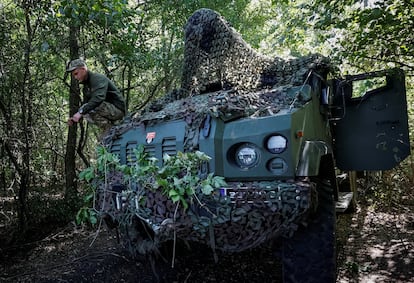
Mile-long trenches
Attacking always implies more human losses than defending — at least three times as many, according to military theorists. And, since World War II, no army has faced the 500 miles of Russian defensive fortifcations that have been constructed. There are moats, anti-tank obstacles, trenches that are 10 feet deep and connected with tunnels, telephone cables that allow for communication without radio (and, therefore, without risk of being intercepted) and machine gun nests made of concrete. There are also, according to experts, more mines per square foot than in most conflicts that have taken place.
Neither side publishes its casualty figures, but the United States does communicate its estimates. In February 2023, if the Pentagon estimated that the Ukrainian side had 100,000 casualties (including wounded and dead), the number in August would have nearly doubled, reaching up to 190,000. On the Russian side, according to Washington, up until August, the total number of casualties must have reached 300,000 soldiers. Military sources fighting on the frontlines of the Ukrainian offensive give the 47th Separate Mechanized Brigade as an example — a recently-created brigade with armored vehicles supplied by NATO, and manned by soldiers who were trained abroad. The 47th Brigade was the spearhead of the first stages of the counteroffensive: it suffered between 30% and 40% casualties, meaning that nearly 2,000 of its 5,000 members were wounded or killed.
Without air superiority, any army would be doomed in a scenario like the one currently facing Ukraine. This is the conclusion of an analysis of the first three months of the counteroffensive published by War on the Rocks, an online publication staffed by two of the most-cited military experts on this war, Michael Kofman and Rob Lee. Ukraine doesn’t have air power yet, but despite this, the Ukrainian Armed Forces have broken the first line of Russian defenses, which was six miles wide and six miles deep. The bad news for Ukrainian prospects, according to Kofman and Lee, is that they have already had to incorporate brigades that were being kept in reserve on the Zaporizhzhia front.
In the first months of the counteroffensive, five of the nine newly-created brigades — bolstered with NATO-provided training and equipment — had taken the lead, according to the two military experts. Since mid-August, according to their analysis, after 18 months of war, fresh reserve battalions have had to enter the conflict, as wear and tear set in. “The future will be determined by which side has more reserves and better manages its combat capability in the long term,” Kofman and Lee affirm. The problem for Ukraine is that its human resources are much more limited than those of Russia. But the good news for Kyiv is that the Kremlin is also pulling regiments that were in reserve, as noted on September 11 by Ukrainian President Volodymyr Zelenskiy, in an interview with The Economist.
The two military experts have identified a substantial change in Ukrainian offensive tactics — a return to the strategies that yielded results in the 2022 liberation of Kharkiv province and the western half of Kherson province. Up to four Ukrainian soldiers in the war zone confirm that this shift has occurred recently, to prioritize assaults by small infantry groups, squads or platoons — each containing between six and 30 soldiers — with armored vehicles withheld for indirect support. “The easiest way to die here is to get inside a tank,” Volodymyr notes. He’s a National Guard officer stationed on the eastern flank of the Ukrainian advance.
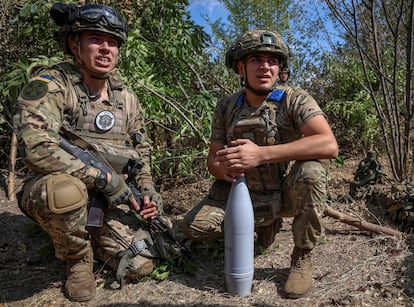
More respect for the enemy
Volodymyr’s men are trying to widen the gap through which the counteroffensive is progressing, to prevent the enemy from surrounding them. The further the Ukrainian Armed Forces venture into territory occupied by Russia, the more difficult it will be to maintain the logistics chain for the troops.
During a moment of rest in the municipality of Huliaipole, about four miles from the front, Voloydymr speaks with EL PAÍS. The exchange of shell fire accompanies the conversation: his hand and his voice tremble. He speaks with respect about his rival, as do the rest of the soldiers interviewed for this report. This represents a change in perception among the Ukrainian troops, who, until a few months ago, felt that the enemy was poorly-prepared and unmotivated. “We’re seeing that they’re better trained, they have more experience. And the worst thing is that they have better weapons — they have everything in the trenches,” Volodymyr sighs. “All they need is for one of our tanks to hit a mine for the entire column to stop. In a matter of minutes, we can be [wiped out] with portable missiles from the trenches, with drone bombs, with artillery or aerial fire.”
Speaking next to Volodymyr is Serhii Kuk — a military veteran of a Special Forces unit that has been fighting since 2014, since the war in Donbas. Kuk, his code name, has just recovered from his seventh wound during the current war. For him, the Kremlin’s smartest move was the battle of Bakhmut, a city in the Donetsk region taken by Russia last spring, after nine months of fighting. “Bakhmut screwed us,” he grunts. According to his interpretation of what happened, the Ukrainian Army was greatly worn out while the Russians essentially burned Wagner’s mercenaries there. “Meanwhile, they reinforced the defenses on the southern front (that of Zaporizhzhia towards the Sea of Azov).” Kuk describes the first phase of the counteroffensive, in June and July, as disastrous. Dozens of armored vehicles were lost, including those supplied by NATO allies.
Until the taking of Robotyne, on August 28, the Ukrainian Army persevered in armored infantry assaults with the direct intervention of tanks. What the Ukrainian Armed Forces want to avoid is the experience that left Alexander’s company without half of its strength, even though the objective of the mission — to take the Russian position — was ultimately achieved. The eight tanks split into two groups of four to assault a Russian defensive line at Robotyne. The first two tanks of each group were ordered to approach within 1,600 feet of the Russian defenses. “They arrived [650 feet] from the Russian trenches… the idea was to scare them and make them flee.” Mines and anti-tank missiles destroyed the armored vehicles that were paving the way, resulting in the rest of the advancing columns being blocked. In an instant, hell descended on them, according to those who managed to escape.
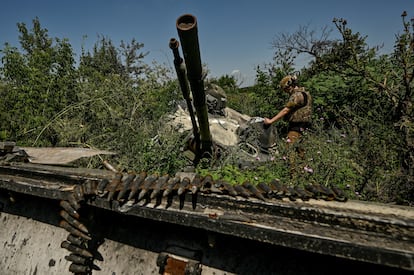
An uneven fight
Alexander Rose is a member of the Tora special forces group, one of the best-known units in Ukraine. They were among the first to enter the city of Kherson in November 2022 and are now conducting rapid strike operations in the Zaporizhzhia offensive, prodding Russian positions in small raids. Rose confirms that this will be the tactic from now on, similar to what they did for six months in Kherson until the enemy withdrew. The difference is that, back then, the Russian defenses were weak. That’s not the case today.
Rose is asking for time to punish and demoralize the Russian front, by utilizing constant drone attacks, artillery and nighttime assaults. “This is like a boxing match between a huge fighter and a small one. The little guy has no chance if he goes head-to-head… but if you tire the big guy out, moving fast and hitting him incessantly, the little guy can win.”
The minefields will continue to be a major problem. Rose estimates that, for every square foot, there’s an anti-personnel mine. The Tora group has identified them, suffering — in all ways imaginable — in order to clear the fields. Rose emphasizes that the worst ones are the anti-personnel mines that have motion sensors: these are mines that are connected to each other via transmissions. Three mines form a perimeter. When one detects the movement of people, they detonate at the same time, sending shrapnel flying in a radius that spans 40 feet. “They’re calibrated to identify whether the movement is that of a person, an animal or a vehicle… they only explode if people cross them,” Rose says.
The Ukrainian Armed Forces have already broken the first defensive line and now face the second — out of a total of three — which surrounds the city of Melitopol, the objective of the counteroffensive. Analysts and military personnel in the theater of operations agree that the second line is the weakest, but there are disagreements about what comes after this. The Institute for the Study of War, an American analysis center now focused on the conflict in Ukraine, quoted Yevhen Dyky, a renowned retired Ukrainian officer, on September 7. He stated that the third line is the weakest because it’s made up of “command posts, warehouses and support [units] for the previous two.” Senior Ukrainian commanders also told The Guardian that Moscow has allocated 80% of its capacity to the first two lines.
However, in a September 6 interview with The Economist, Trent Maul, director of the U.S. Defense Intelligence Agency, warned otherwise, saying that the last line of defense will probably be the most complicated, because it’s where the most resources are concentrated. It’s also close to the logistical supply routes from Russia. Rose is of the same opinion: “If, on the first line, we encountered 70% of the Russian potential, on the second, we’re facing 40%. In the third, [we will encounter] 100% of its power.”
The intelligence services for the United Kingdom’s Ministry of Defense reported this past Sunday that Russian troops are further fortifying their defenses in the municipality of Tokmak, located 10 miles from the front, to turn it into the main bastion of the second defensive line. The more time passes, the more obstacles Ukrainian forces will encounter.
The Economist quoted a representative of the American government, who estimated that the current Ukraine counteroffensive has a remaining margin of six weeks, until the autumn and winter rains begin. The rain makes the movement of heavy equipment difficult, while the cold reduces the infantry’s capacity for combat. Zelenskiy has stated that none of this will stop his soldiers’ progress. “In winter, we will continue fighting, hitting them to demoralize them,” Rose adds. They have no other option. Melitopol is still 43 miles away from the Ukrainian Armed Forces. If the average of 300 feet a day is maintained, the city would be reached in two years. Few in Ukraine or in its allied countries want the war to last this long.
Sign up for our weekly newsletter to get more English-language news coverage from EL PAÍS USA Edition
Tu suscripción se está usando en otro dispositivo
¿Quieres añadir otro usuario a tu suscripción?
Si continúas leyendo en este dispositivo, no se podrá leer en el otro.
FlechaTu suscripción se está usando en otro dispositivo y solo puedes acceder a EL PAÍS desde un dispositivo a la vez.
Si quieres compartir tu cuenta, cambia tu suscripción a la modalidad Premium, así podrás añadir otro usuario. Cada uno accederá con su propia cuenta de email, lo que os permitirá personalizar vuestra experiencia en EL PAÍS.
¿Tienes una suscripción de empresa? Accede aquí para contratar más cuentas.
En el caso de no saber quién está usando tu cuenta, te recomendamos cambiar tu contraseña aquí.
Si decides continuar compartiendo tu cuenta, este mensaje se mostrará en tu dispositivo y en el de la otra persona que está usando tu cuenta de forma indefinida, afectando a tu experiencia de lectura. Puedes consultar aquí los términos y condiciones de la suscripción digital.
More information
Archived In
Últimas noticias
Most viewed
- Oona Chaplin: ‘I told James Cameron that I was living in a treehouse and starting a permaculture project with a friend’
- Reinhard Genzel, Nobel laureate in physics: ‘One-minute videos will never give you the truth’
- Sinaloa Cartel war is taking its toll on Los Chapitos
- Why the price of coffee has skyrocketed: from Brazilian plantations to specialty coffee houses
- Silver prices are going crazy: This is what’s fueling the rally
